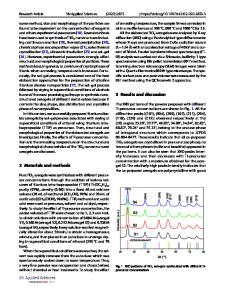Effects of Annealing on Structural and Magnetic Properties of Cobalt Implanted TiO 2 Thin Films
- PDF / 1,022,110 Bytes
- 12 Pages / 595 x 842 pts (A4) Page_size
- 81 Downloads / 383 Views
0999-K05-07
Effects of Annealing on Structural and Magnetic Properties of Cobalt Implanted TiO2 Thin Films W. Y. Luk1, Q. Li2,3, S. P. Wong1,3, H. P. Ho1, N. Ke1, and J. K. N. Lindner4 1 Department of Electronic Engineering, The Chinese University of Hong Kong, Shatin, Hong Kong 2 Department of Physics, The Chinese University of Hong Kong, Shatin, Hong Kong 3 Materials Science & Technology Research Centre, The Chinese University of Hong Kong, Shatin, Hong Kong 4 Institut fur Physik, University of Augsburg, Augsburg, Germany ABSTRACT Since the observation of room-temperature ferromagnetism (RTFM) in Co-doped anatase TiO2 [1], there have been many reports on the study of the magnetic properties of Co-doped TiO2 prepared by various methods with diversified results. The origin of the RTFM in these systems is still a topic of controversy today. In this work, TiO2 thin films were prepared by RF sputtering onto thermally grown oxide layers on Si substrates. Cobalt implantation was performed using a metal vapor vacuum arc (MEVVA) ion source to various doses ranging from 3x1015 cm-2 to 4x1016 cm-2. Post-implantation annealing was performed in a vacuum chamber at various temperatures ranging from 400oC to 700oC for 2 hours and 4 hours. Characterization of these films as-implanted and after thermal annealing under various conditions was performed using Rutherford backscattering spectrometry, energy filtered and high-resolution transmission electron microscopy, x-ray diffractometry, x-ray photoelectron spectroscopy, and vibrating sample magnetometry. The dependence of the magnetic properties on the implantation and annealing conditions were studied in detail. Clear RTFM properties were observed. The saturation magnetic moment per implanted Co atom (MS) seems to increase with increasing dose within the implantation dose range in this study. At a fixed dose, the MS value also shows a generally increasing trend with increasing annealing temperature and annealing time. Quite a number of samples showed MS values exceeding the bulk Co value of 1.69 µB/Co significantly and the maximum MS value observed is about 3.16 µ B/Co. Such high MS values indicate that the RTFM must not come from Co clusters alone. Possible origins of the RTFM properties will be discussed in conjunction with the structural properties. INTRODUCTION Diluted magnetic semiconductors (DMS), which mostly consisted of III-V semiconductors containing transition-metal magnetic impurities, have attracted a lot of research interest since the discovery of room-temperature ferromagnetism (RTFM) in Co-doped anatase TiO2 by Matsumoto et al. [1]. Growth of this DMS by thin film techniques, such as oxygen plasma-assisted molecularbeam epitaxy (OPA-MBE) or pulsed laser deposition (PLD) [2] has been reported. The average magnetic moments per Co atom reported were 0.32 µ B/Co by Matsumoto et al. for laser ablated films and about 1.1 to 1.3 µ B/Co for the films grown by OPA-MBE by Chambers et al. [3]. However, there is still controversy about the origin of ferromagnetism. Theoretica
Data Loading...











